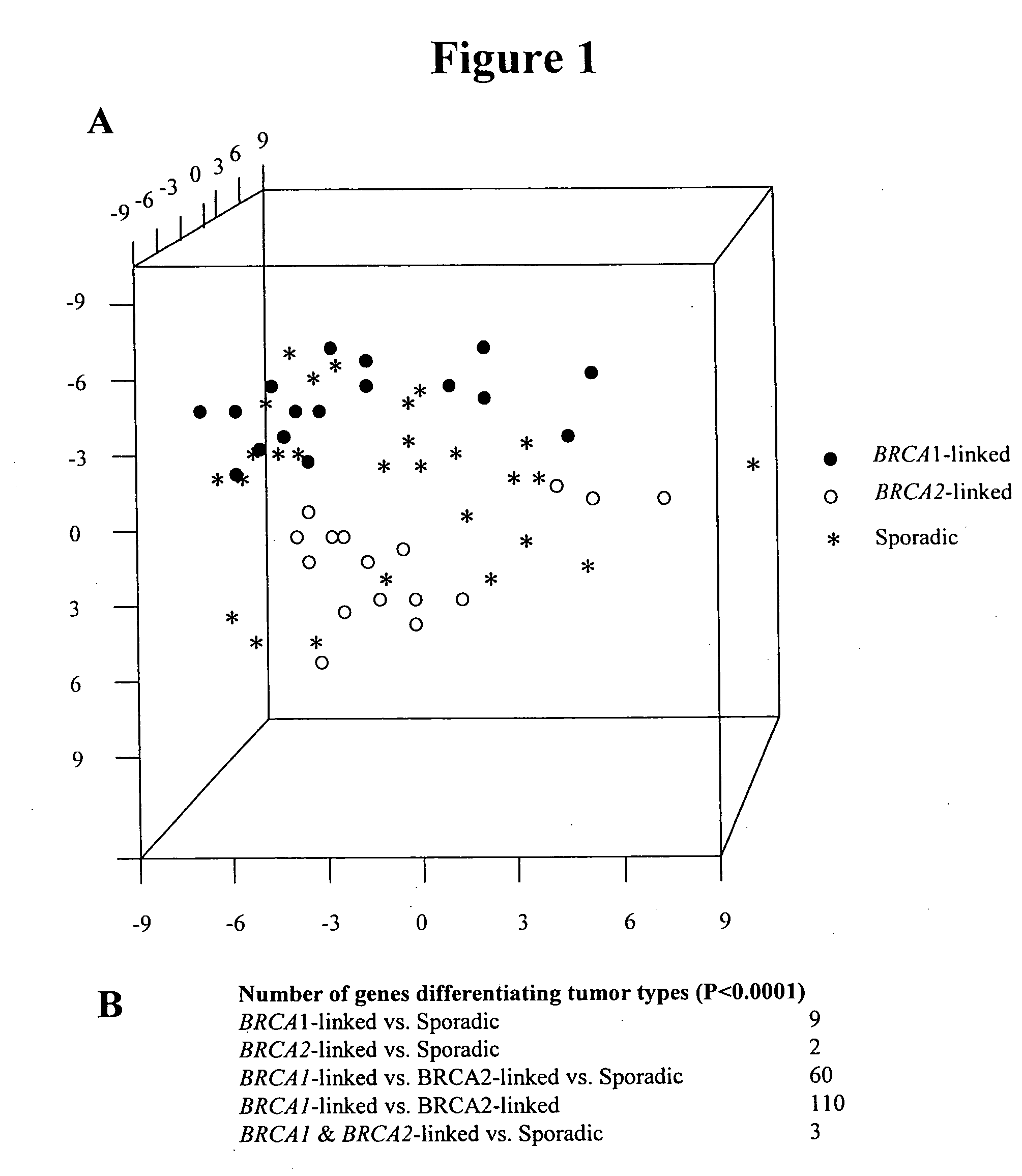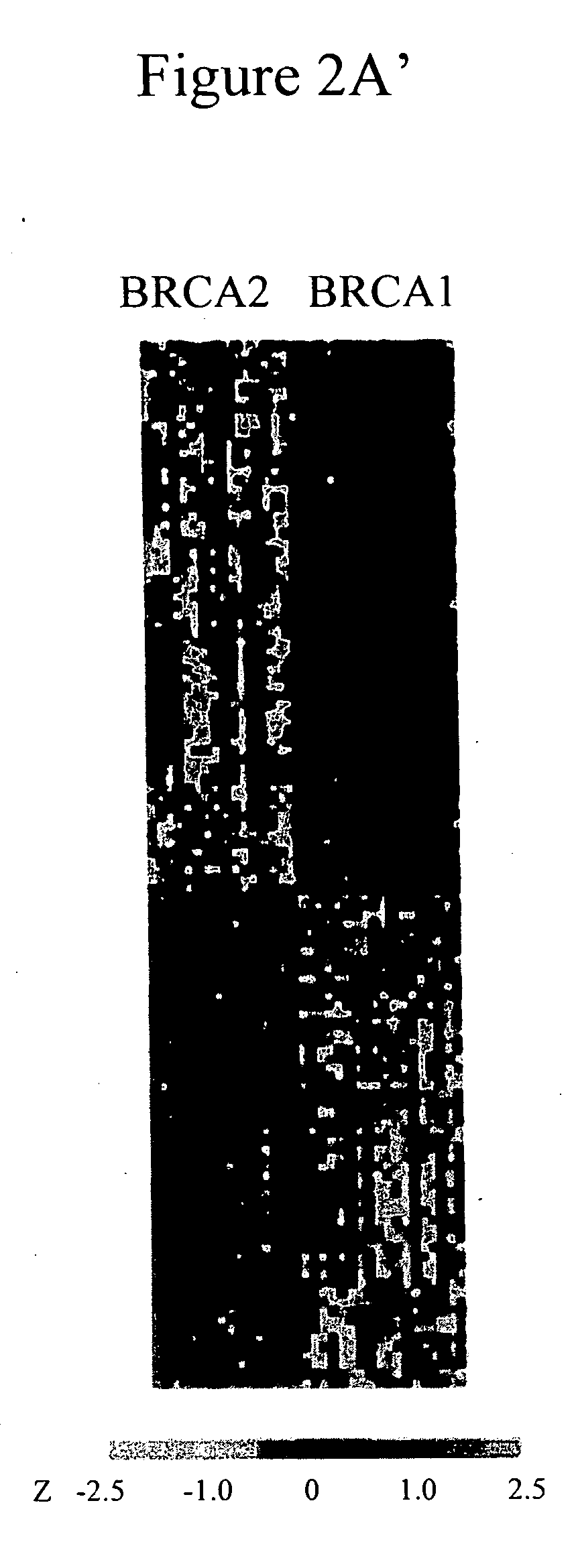Identification of ovarian cancer tumor markers and therapeutic targets
a technology for identifying and treating tumors, applied in the field of ovarian cancer, can solve the problems of ovarian cancer having one of the highest mortality rates of all cancers
- Summary
- Abstract
- Description
- Claims
- Application Information
AI Technical Summary
Benefits of technology
Problems solved by technology
Method used
Image
Examples
example 1
Identification of Genes with Altered Expression in Ovarian Cancer
[0199] This example describes how a first subset of the disclosed ovarian cancer-related nucleic acid molecules were identified. These ovarian cancer-related molecules show differences in expression in subjects having ovarian cancer compared to normal ovarian surface epithelial cells and are classified according to their BRCA-1, BRCA-2, and sporadic tumor status. The results of these studies have been published in Jazaeri et al., J. Natl. Cancer Inst., 94(13): 990-1000, 2002, which is incorporated by reference in its entirety herein.
Methods and Material:
[0200] Clinicopathologic characteristics of BRCA-linked and sporadic ovarian cancers: Sixty-one cases of pathologically-confirmed epithelial ovarian adenocarcinoma from the Memorial Sloan-Kettering Cancer Center were studied and screened for founder mutations. These included eighteen cases linked to BRCA1, sixteen cases linked to BRCA2, and twenty-seven sporadic cas...
example 2
Semiquantitative RT-PCR Confirms and Complements cDNA Microarray Data
[0230] This example describes how the results found in the previous example were confirmed using semiquantitative RT-PCR.
[0231] To validate the array data, semiquantitative RT-PCR (sqRT-PCR) analysis of several mRNAs was performed in a representative subset of tumors consisting of five BRCA1-linked, five BRCA2-linked, and five sporadic RNA samples. The tumor samples were randomly selected. The expression of TOP2A (SEQ ID NO: 448), RGS1 (SEQ ID NO: 398, CD74 (SEQ ID NOS: 89-91, 92-93), HE4 (SEQ ID NO: 60), HLA-DRB1 (SEQ ID NO: 87-88), and ZFP36 (SEQ ID NO: 167-168, 169-171, 172-173) were evaluated using sqRT-PCR, with β-actin as a normalizing control. Because data obtained from cDNA microarrays is in the form of relative expression ratios between tumors and the reference, RNA from IOSE cells and a histologically normal, postmenopausal ovarian RNA sample in the sqRT-PCR experiments was included for comparison. The ...
example 3
Identification of Additional Genes with Altered Expression in Ovarian Cancer
[0235] This example provides a description of how additional disclosed ovarian cancer-related nucleic acid molecules were identified. These ovarian cancer-related molecules show differences in expression in subjects having ovarian cancer compared to expression in normal ovarian surface epithelial cells.
[0236] Using a different microarrays and methods essentially similar to those described above in Example 1, thirty-one ovarian epithelial cancers were compared to two normal postmenopausal ovarian samples. 141 additional ovarian cancer-related nucleic acid molecules were identified and further characterized (Tables 6 and 7, Addendum).
Methods and Materials:
[0237] Methods and materials were similar to those described in Example 1, except that different microarrays were used. The nucleic acids constituted 7,600 features, and representing different (non-redundant) transcripts including multiple known named ge...
PUM
| Property | Measurement | Unit |
|---|---|---|
| size | aaaaa | aaaaa |
| color intensities | aaaaa | aaaaa |
| nucleic acid sequences | aaaaa | aaaaa |
Abstract
Description
Claims
Application Information
 Login to View More
Login to View More - R&D
- Intellectual Property
- Life Sciences
- Materials
- Tech Scout
- Unparalleled Data Quality
- Higher Quality Content
- 60% Fewer Hallucinations
Browse by: Latest US Patents, China's latest patents, Technical Efficacy Thesaurus, Application Domain, Technology Topic, Popular Technical Reports.
© 2025 PatSnap. All rights reserved.Legal|Privacy policy|Modern Slavery Act Transparency Statement|Sitemap|About US| Contact US: help@patsnap.com



